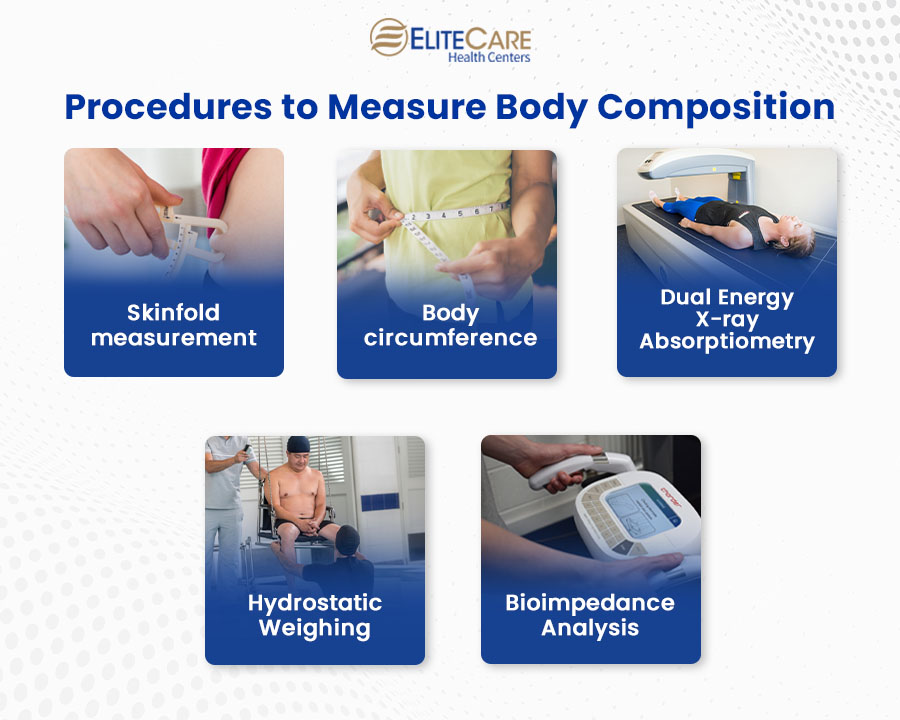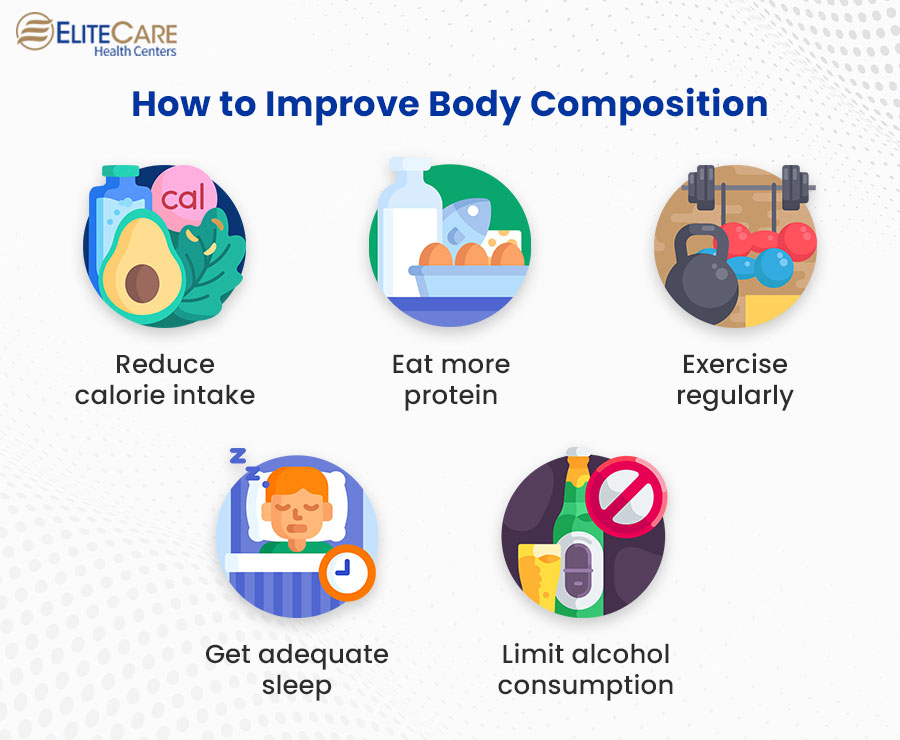
The term body composition represents the proportions of different components that make up the human body. It includes measuring the relative amounts of fat, muscle, bone, and other tissues in the body to provide insights into an individual’s overall health and fitness.
There are two main components, namely fat mass and fat-free mass, that explain body composition. While fat mass refers to the amount of adipose tissue (body fat) present in the body, fat-free mass includes all other tissues, such as muscle, bone, organs, and fluids.
In this blog post, we will share a detailed understanding of body composition tests and how to improve it. Read on to learn more.
Body Composition vs. Body Mass Index - What's the Difference?
Body composition and body mass index (BMI) are two distinct measurements used to assess different aspects of an individual’s physical characteristics. While they both provide insights into a person’s health and body composition, they differ in terms of what they specifically measure and how they are calculated.
Body composition provides a detailed analysis of the distribution of muscle, bone, and other tissues in the body. It allows primary care physicians to get an accurate assessment of overall health and fitness. On the other hand, BMI is a simple mathematical calculation that considers an individual’s weight to their height. Physicians check it to roughly estimate body fat, which helps them assess potential health risks.
Individuals can calculate their BMI by dividing their weight in kilograms by the square of their height in meters.
While BMI can be a useful starting point for assessing weight-related health risks, it has limited capability to reflect individual assessments. In contrast, body composition testing provides a more comprehensive understanding, which is particularly valuable for identifying potential health risks associated with excessive fat mass or low muscle mass.
Benefits of Body Composition Test for Seniors
As we grow older, our bodies naturally experience a decline in muscle mass, a condition known as sarcopenia. Additionally, our bone mineral density may also decrease with age, increasing our risk of osteoporosis and fractures. Routine body composition tests can detect any such health risk early on, enabling us to seek medical attention on time.
Besides, body composition testing can also help seniors understand the amount of visceral fat (fat around internal organs) in their bodies. Excessive visceral fat can increase the risk of chronic conditions such as cardiovascular disease, diabetes, and metabolic syndrome.
With the help of body composition analysis, healthcare providers can tailor nutrition and exercise regimens according to the specific needs of seniors.
How Is Body Composition Measured?

1. Skinfold measurement
In this method, physicians use calipers to measure the thickness of skinfolds at specific sites on the body, such as the triceps, abdomen, and thigh. These measurements can estimate the amount of subcutaneous fat or fat beneath the skin present in your body. Skinfold measurements are relatively simple and cost-effective.
2. Body circumference
This method can measure the circumference of certain body parts, such as the waist, hips, and limbs. Healthcare professionals use these measurements in conjunction with mathematical formulas to estimate body composition.
For example, physicians often use waist circumference as an indicator of abdominal fat, which can increase the risk of several chronic health issues. Body circumference measurements are easy to perform, providing a more generalized estimation of body composition compared to other methods.
3. Dual Energy X-ray Absorptiometry (DXA)
DXA is one of the most accurate methods that physicians recommend for measuring body composition. It uses low-dose X-rays to differentiate between fat, lean tissue (including bone and muscle), and mineral content.
However, this procedure usually requires specialized training and equipment, and is more expensive.
4. Hydrostatic weighing
Also known as underwater weighing, hydrostatic weighing involves measuring a person’s weight in and out of water to calculate body density. From there, healthcare professionals use established formulas to estimate body fat percentage. Hydrostatic weighing is considered highly accurate, but it requires specialized equipment and expertise, as well as the ability to fully exhale and remain submerged underwater.
5. Bioimpedance Analysis (BIA)
It measures body composition by passing a low electrical current through the body and analyzing the resistance encountered. Since different tissues conduct electricity differently, BIA can estimate the body’s fat mass and fat-free mass. This procedure is relatively quick to perform, often using handheld devices or scales.
Each body composition test has its limitations. Factors such as hydration level, exercise, and measurement technique can affect the accuracy of results.
How to Improve Body Composition

1. Reduce calorie intake
To improve body composition, it’s important to create a calorie deficit, which means consuming fewer calories than your body needs for daily activities and maintenance. Individuals can achieve this through a few measures like portion control, mindful eating, and making healthier food choices. It is also crucial to eat more nutrient-dense foods such as fruits, vegetables, lean proteins, whole grains, and healthy fats, while limiting processed foods, sugary snacks, and high-calorie beverages.
2. Eat more protein
Including an adequate amount of protein in a regular diet can preserve and build lean muscle mass. In return, it can help increase metabolism and promote fat loss.
Good sources of protein include lean meats, poultry, fish, eggs, dairy products, legumes, and plant-based options like tofu and tempeh. Aim for a protein intake of around 0.8-1 gram per kilogram of body weight per day.
3. Exercise regularly
Combining cardiovascular exercise such as walking, jogging, cycling, or swimming with resistance training can help build muscle, burn calories, and promote fat loss. Seniors can opt for lighter weights, resistance bands, etc. as a part of their strength training routine.
Start slowly and set your goal to exercise for at least 150 minutes per week, along with two or more days of strength training exercises targeting major muscle groups.
4. Get adequate sleep
Sufficient sleep plays a vital role in body composition and overall health. Lack of sleep can lead to several health issues by disrupting hormonal balance and eventually resulting in increased hunger, cravings, and decreased metabolism.
Aim for 7-9 hours of quality sleep each night to support optimal body composition. Establish a regular sleep schedule, create a comfortable sleep environment, and practice relaxation techniques to manage stress which can disrupt quality sleep.
Discover more: Common Sleep Problems and Solutions for the Elderly
5. Limit alcohol consumption
Alcohol provides empty calories, impairs metabolism, and can lead to poor food choices. Additionally, excessive alcohol intake can negatively affect sleep quality and recovery. Therefore, drinking in moderation can help maintain a healthy body composition and overall good health.
Individual requirements may vary in terms of diet and fitness changes. Consult a primary care physician or registered dietitian to develop a personalized plan that considers any underlying health conditions or dietary restrictions one may have.
The Bottom Line
Body composition testing holds great importance in assessing the overall health and well-being of seniors. It allows for personalized nutrition and exercise plans, promoting healthy aging and an improved quality of life. Seniors can make significant improvements in their body composition by following the diet and lifestyle modifications outlined in this blog.
For any queries or concerns about senior health and wellness, contact EliteCare Health Centers and schedule an appointment with our board-certified primary care physicians. We are a primary care medical clinic in Florida, specializing in a wide range of senior care services, including venipuncture, wellness care, routine physical exam, preventive care, etc.






